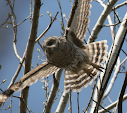
During today's lunch I walked for my second time at Ketner Reservoir. It is a smallish lake in the middle of a neighborhood, but one that I hope will prove to be a good little patch to check on every once in a while. Today I didn't see anything exceptional, but did get a few good shots of more common birds, thanks to playing with Exposure Compensation.
The Northern Flicker above was foraging on the ground beneath some mature trees. The bird itself was shaded a bit, but the patch of grass just behind was bright enough to trick my camera's sensor into thinking the scene was well lit. Knowing from a wealth of underexposed subject shots that this bird would lose detail, I set the exposure compensation up a third of a stop. That was enough to bring out the texture and colors on the Flicker, making a fun shot.

This Black-capped Chickadee had such great expressions as it evaluated me from a small tree. To get detail on a bird that is isolated against a bright sky I had to use the same principle as above, but really push it this time. I pushed the exposure up two full stops, and was able to capture the Chickadee's dark face.
As I passed the lake, I spotted a bunch of Redhead Ducks lifting off from the water. While waiting for them to clear a group of trees I took the time to pull the exposure back down to a negative third. That helped to keep the light bodies of the ducks from being blown out where they were in direct sunlight.

I received a practical lesson on exposure compensation last year at the CFO convention on a photography field trip. In the year since I have been practicing... It doesn't always work out, but is a good tool to have in the bag when shooting in the ever changing light conditions that are nature. Needless to say that trip is one I have signed up for again this year.

All nice shots! I love the colors of the flicker: they are such pretty birds!
ReplyDeleteI've been slowly learning about exposure compensation, too -- mostly via "the hard way" from having to discard all the badly underexposed shots afterwards!
ReplyDelete